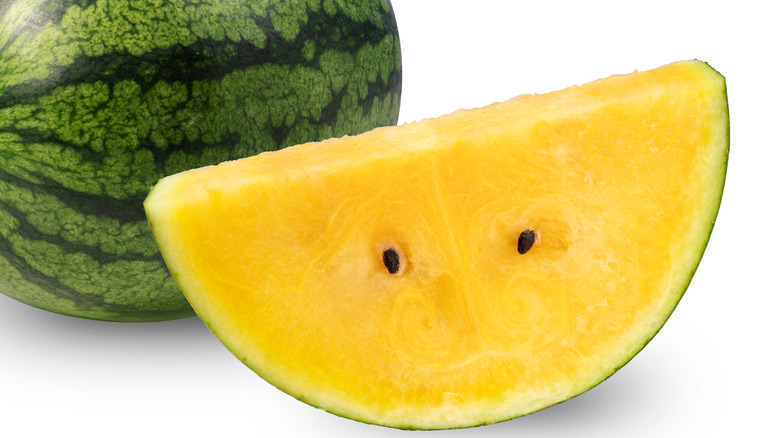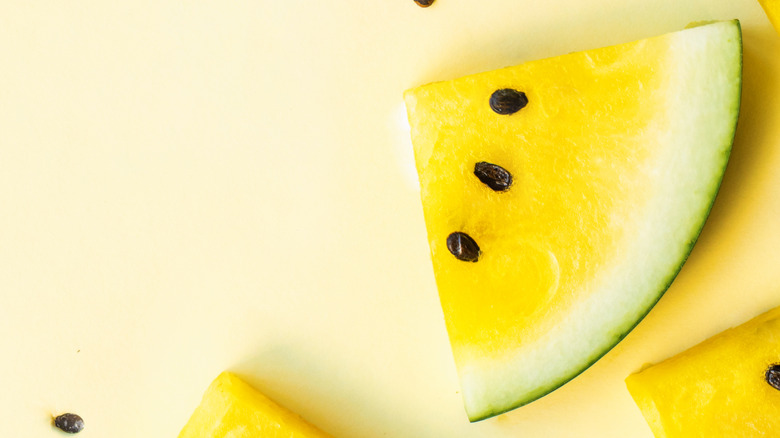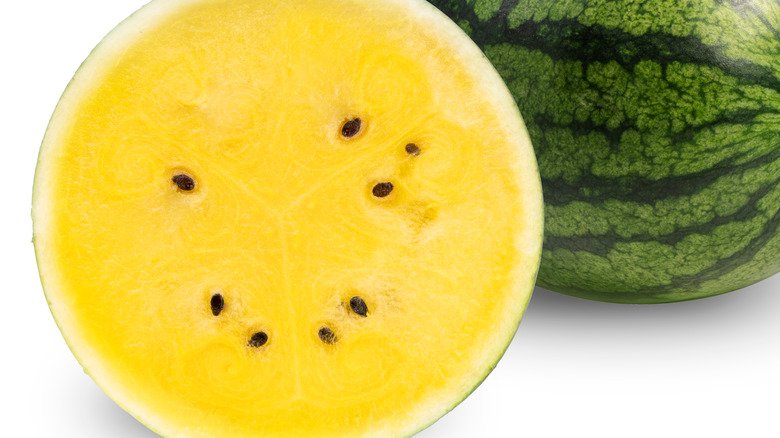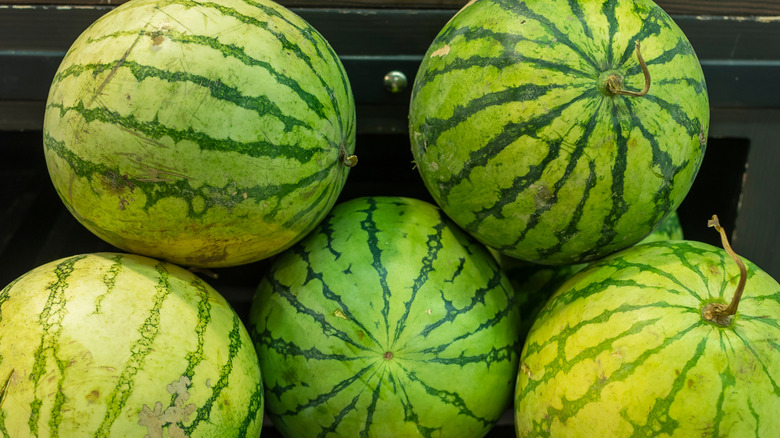What Is A Yellow Watermelon And Where Can You Buy One?
Watermelons may be an iconic part of summer, but we're betting yellow watermelons probably never played a role in your hot weather-related fantasies before, particularly since the fruit we all know and love normally comes in varying shades of pink or red. But, as Farm Flavor points out, yellow watermelons aren't just natural, they actually predate the reddish-hued watermelon by more than a few generations.
Yellow watermelons were first cultivated in Africa thousands of years ago, and it is said that the fruit went through natural cross-breeding for qualities that would eventually determine its flavor, hue, and texture. The fruit only began morphing from yellow to pink when the presence of a plant nutrient called lycopene began to make itself seen, which caused the watermelon's insides to turn pink and then red. Botanically, yellow watermelons are known as Citrullus lanatus and are part of the Cucurbitaceae family (via Specialty Produce), making this particular fruit a gourd, and a kissing cousin to pumpkins and squashes (via Britannica).
Yellow and red watermelons look almost identical on the outside, and when ripe, they taste very similar, although What About Watermelon says the sweetness of a yellow watermelon is reminiscent of honey.
Where do yellow watermelons originate?
Yellow watermelons might be considered "exotic" here, but they are far from that on the African continent. There, yellow watermelons thrive under challenging conditions for a plant; That is, dry and hot weather. Their ability to hold water makes them especially precious in a land where water is scarce, so it should come as no surprise that yellow watermelons are also known as "desert kings." They even play a supporting role in wall paintings found in King Tutankhamun's tomb, and some experts believe the fruit might have been left in burial areas so kings would have a hydration source as they moved from this world into the next. Yellow watermelons were also found along trade routes — their seeds were sold, while the flesh was used to keep traveling explorers from becoming dehydrated (via Specialty Produce).
But these prehistoric yellow watermelons appear to be the kind of fruits you wouldn't write home about. While they were a good hydration source, they didn't have much flavor — so it is no surprise that enterprising souls decided to try and breed the yellow watermelon so it might have more sugar and more flavor. It was during this time that watermelons became sweeter and more flavorful with pink and red-colored flesh.
Are yellow watermelons nutritious?
While reddish watermelons are high in lycopene, a plant antioxidant which can also be found in tomatoes, yellow watermelons are high in beta-carotene, an antioxidant that adds a golden blush to cantaloupes and pumpkins, shares MasterClass – and even carrots, for whom this plant nutrient is named (via Mount Sinai). Other than beta-carotene, yellow watermelons are packed with Vitamins A and C, and contain 12 grams of carbs, 10 of which are sugar, and 1 gram of protein. One of the best things about yellow watermelon is that a one cup serving comes in at 46 calories (via Livestrong).
And don't let the colors fool you — red, pink, and yellow watermelons have similar textures — all are juicy and crisp, and they all taste very similar, although as MasterClass points out, some types of yellow watermelon can be sweeter, with honey-like undertones. Yellow watermelons can be used the same way as red and pink watermelons — they can be enjoyed on their own as fruits, or in juices and smoothies, in salads, or as part of a summery cocktail.
How can you find yellow watermelons?
While there are many upsides to the yellow watermelon, the only downside to the fruit would be that getting your hands on one won't be as easy as you might want it to be. MasterClass says your best bet would be to go to a local farmer's market, or go to a fruit shop which may specialize in more difficult-to-get produce. But when you see an uncut watermelon, know that there is no way for an untrained eye to distinguish between a yellow watermelon from a red or pink one, since on the outside, they all pretty much look the same.
Once you come face to face with a yellow watermelon, changes are you'd be looking at one of five different varieties: The "yellow crimson," which isn't too different from the more traditional pink watermelons, the "buttercup yellow melon," which is seedless and very sweet, the "yellow flesh black diamond," which has a dark green rind and isn't as sweet as its other yellow watermelon siblings, the "desert king," which looks like a cantaloupe, and last but not least, and the "yellow doll," which is small, crisp, sweet, and juicy.



